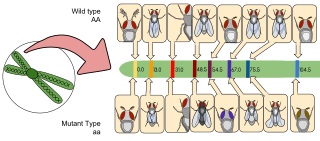Theory and sequencing strategies
Sequencing as a covering problem
All mainstream methods of DNA sequencing rely on reading small fragments of DNA and subsequently reconstructing these data to infer the original DNA target, either via assembly or alignment to a reference. The abstraction common to these methods is that of a mathematical covering problem. [2] For example, one can imagine a line segment representing the target and a subsequent process where smaller segments are "dropped" onto random locations of the target. The target is considered "sequenced" when adequate coverage accumulates (e.g., when no gaps remain).
The abstract properties of covering have been studied by mathematicians for over a century. [3] However, direct application of these results has not generally been possible. Closed-form mathematical solutions, especially for probability distributions, often cannot be readily evaluated. That is, they involve inordinately large amounts of computer time for parameters characteristic of DNA sequencing. Stevens' configuration is one such example. [4] Results obtained from the perspective of pure mathematics also do not account for factors that are actually important in sequencing, for instance detectable overlap in sequencing fragments, double-stranding, edge-effects, and target multiplicity. Consequently, development of sequencing theory has proceeded more according to the philosophy of applied mathematics. In particular, it has been problem-focused and makes expedient use of approximations, simulations, etc.
Early uses derived from elementary probability theory
The earliest result may be found directly from elementary probability theory. Suppose we model the above process taking and as the fragment length and target length, respectively. The probability of "covering" any given location on the target with one particular fragment is then . (This presumes , which is valid often, but not for all real-world cases.) The probability of a single fragment not covering a given location on the target is therefore , and for fragments. The probability of covering a given location on the target with at least one fragment is therefore
This equation was first used to characterize plasmid libraries, [5] but it may appear in a modified form. For most projects , so that, to a good degree of approximation
where is called the redundancy. Note the significance of redundancy as representing the average number of times a position is covered with fragments. Note also that in considering the covering process over all positions in the target, this probability is identical to the expected value of the random variable , the fraction of the target coverage. The final result,
remains in widespread use as a "back of the envelope" estimator and predicts that coverage for all projects evolves along a universal curve that is a function only of the redundancy.
Lander-Waterman theory
In 1988, Eric Lander and Michael Waterman published an important paper [6] examining the covering problem from the standpoint of gaps. Although they focused on the so-called mapping problem, the abstraction to sequencing is much the same. They furnished a number of useful results that were adopted as the standard theory from the earliest days of "large-scale" genome sequencing. [7] Their model was also used in designing the Human Genome Project and continues to play an important role in DNA sequencing.
Ultimately, the main goal of a sequencing project is to close all gaps, so the "gap perspective" was a logical basis of developing a sequencing model. One of the more frequently used results from this model is the expected number of contigs, given the number of fragments sequenced. If one neglects the amount of sequence that is essentially "wasted" by having to detect overlaps, their theory yields
In 1995, Roach [8] published improvements to this theory, enabling it to be applied to sequencing projects in which the goal was to completely sequence a target genome. Michael Wendl and Bob Waterston [9] confirmed, based on Stevens' method, [4] that both models produced similar results when the number of contigs was substantial, such as in low coverage mapping or sequencing projects. As sequencing projects ramped up in the 1990s, and projects approached completion, low coverage approximations became inadequate, and the exact model of Roach was necessary. However, as the cost of sequencing dropped, parameters of sequencing projects became easier to directly test empirically, and interest and funding for strategic genomics diminished.
The basic ideas of Lander–Waterman theory led to a number of additional results for particular variations in mapping techniques. [10] [11] [12] However, technological advancements have rendered mapping theories largely obsolete except in organisms other than highly studied model organisms (e.g., yeast, flies, mice, and humans).
Parking strategy
The parking strategy for sequencing resembles the process of parking cars along a curb. Each car is a sequenced clone, and the curb is the genomic target. [13] Each clone sequenced is screened to ensure that subsequently sequenced clones do not overlap any previously sequenced clone. No sequencing effort is redundant in this strategy. However, much like the gaps between parked cars, unsequenced gaps less than the length of a clone accumulate between sequenced clones. There can be considerable cost to close such gaps.
Pairwise end-sequencing
In 1995, Roach et al. [14] proposed and demonstrated through simulations a generalization of a set of strategies explored earlier by Edwards and Caskey. [15] This whole-genome sequencing method became immensely popular as it was championed by Celera and used to sequence several model organisms before Celera applied it to the human genome. Today, most sequencing projects employ this strategy, often called paired end sequencing.





















